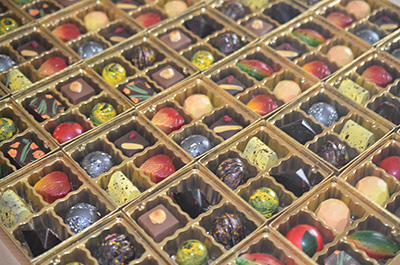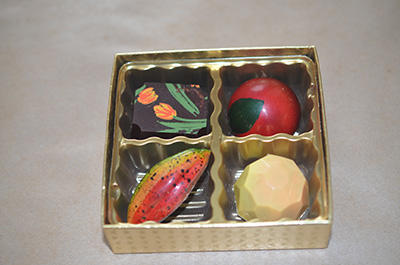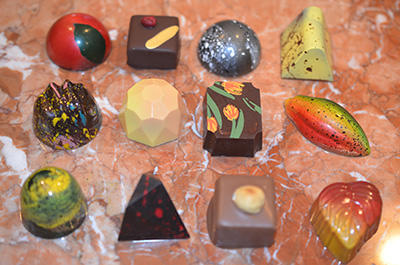-
Posts
2,415 -
Joined
-
Last visited
Content Type
Profiles
Forums
Store
Help Articles
Everything posted by Jim D.
-
What I currently do (always subject to change as more information comes in) is to use paper towels moistened with hot water to remove as much chocolate left on the mold edges as I can (yes, I know there shouldn't be any, but... I'm still learning, and I desperately want to keep my drain clear of solidified cocoa butter), then wash the molds with a new sponge using dishwashing liquid (Dawn, to be precise) and hot water, rinse them thoroughly in hot water, soak them a while in a solution of bleach and water (as required by the food safety regulations), and let them air-dry in a drainer. Before use I polish them with a cotton cloth. I freely admit, in view of what others have said about not bothering to polish, this may just be superstition, but I still do it.
-
I don't mind sharing what I know at all, happy to do so. I just meant that if you want more details, that thread might be of some help, although there are probably as many opinions on achieving shiny chocolates as there are chocolatiers! Melissa Coppel, just to take one example, polishes her molds with alcohol. And at the opposite extreme, Jin Caldwell in Las Vegas doesn't clean her molds between uses at all.
-
As you can read in the thread on Andrey Dubovik's online course, there is (at least in his opinion--and he makes mirror-like chocolates all the time, even to the point of photographing himself or staff waving and having their image reflected off the shells into the camera) no secret to shiny shells. No polishing with alcohol, no spraying of cocoa butter, no polishing of the mold unless there are visible water spots. Just (!) careful attention to detail--temper the cocoa butter and try to keep it in temper, have the temperature of the room on the cool side (18-20C--though I don't think 18C is necessary because I have seen examples of others who don't work at that temp--and it makes airbrushing an excruciating job requiring near-constant use of a heat gun). My experience has been that even the shiniest bonbons can become dull if they are exposed to humidity or if the filling is something that tends to cause bloom, such as nut oils.
-
Callebaut includes drops on its packages to indicate viscosity--unless what you have was repackaged by someone else. If the drops are sufficient (you can check the meaning of the drops here), then it's possible humidity has affected your chocolate. Are you in an area that is currently experiencing high humidity (as I am where I live)? If you have good AC, you can get that down, but only so much. As you probably know, the constant movement of the Chocovision tempering machines tends to make chocolate get overtempered sooner rather than later, and there are steps you can take to deal with that, but if the machine has worked satisfactorily before in an equivalent span of time in use, I would look to the humidity as a possible cause.
-
My guess is that it is your airbrushing technique causing the spotting. It is ironic that many of us try to achieve this splattering effect with an airbrush (as a decorative technique) without success, and you have done it without even trying! What airbrush are you using and what is your setup? What size is the nozzle? Do you use a compressor? Do you keep your cocoa butter flowing by using a heat gun frequently? You might want to check Youtube for help avoiding splattering when using an airbrush (since it is considered a defect in normal airbrushing). In some of your pieces you have the "orange peel" look, and there is a lot online about avoiding that. You need to avoid being very close to the mold when airbrushing and make several passes rather than try for saturation all at once. When I am airbrushing a half-sphere of around 35mm diameter, it takes me about 4 passes to get full coverage. Some people try to do in one pass, but in layers. There is a long thread on airbrushing technique here on eGullet, and if you haven't read through that, you should. Glad that including a white layer worked as it should.
-
Do you mix your own colored cocoa butter? If so, I would add more powder. Even if you are not adding a white back layer, the colors should show up more than they do. Red, for example, becomes maroon when backed with milk or dark chocolate. That being said, however, yes, you have to spray a layer of white when making shells of milk or dark chocolate. It's a nuisance, but it's the only way to get the vibrant colors of your first image because most colors will fade out--unless you are using a color that already contains some white (such as light yellow or gold).
-
Very witty. Story of my life: Just as I order the material to get into this design, it has become ordinary (and soon passé). Oh well, it will be new to my customers.
-
@Kerry Beal. those are beautiful, each one unique--just like dendrites in the body ("a short branched extension of a nerve cell").
-
@Artisanne, thanks for the helpful photos of the dendrite technique. If one wanted another color, do you think the colored cocoa butter would need to be mixed with white chocolate, or would cocoa butter alone do the trick? I suppose it depends on how much "body" the medium needs to spread properly. How do you keep it from flowing back into the cavity once you lift the putty? From one of the photos it looked as if you put very little of the chocolate-cocoa butter mixture in the cavity. Thanks in advance for any assistance.
-
@vtoselli, those are very nice, quite successful I would say. You said you thought you would use silicone. Is that what you in fact used?
-
@gfron1, I would say particularly the blue ones (first photo) look very "Dubovikian"--you appear to have the "eye" technique down pat. Beautiful. Now do you know what you did differently to achieve it?
-
Just wanted to update the above information with what I found subsequently. Eventually I located an almond oil meant for flavoring (as opposed to salad dressing): Dr. Oetker's bitter almond oil. It is available in various places, including Amazon. It's a German product made with natural flavorings, is very concentrated, and is bottled so that it comes out in droplets. It is delicious and made my bland almond gianduja very flavorful.
-
I know exactly what you mean. When my sister has brought me boxes of chocolates from her European trips, there is scarcely a decoration on any of them (beyond the most basic), and the makers of those chocolates have done fine for at least a few years as chocolatiers! But we are stuck with where we are, and with people's expectations. I live in a small city where many people had never seen chocolates decorated with cocoa butter (maybe a transfer sheet from time to time), but now that they have seen the possibilities.... I myself do not like the taste of cocoa butter, and I can certainly taste it on most of what I make. But not a single person has ever mentioned that taste (even people who are not my friends and can be blunt about mentioning other things they don't like). I have read that Norman Love is the first chocolatier who used colored cocoa butter. If so, curses on you, Norman Love.
-
Even though I mixed some colors in the Dubovik course, it is not something I long to do as a regular thing. It's too messy, especially if the cocoa butter needs to be strained. I also found that arriving at the right amount of colorant for translucent colors is (for me) a matter of guessing because if you spread colored cocoa butter thinly enough, it all looks more or less translucent. So I take the easy way out (not typically what I do, but sometimes we all have to be practical) and use Chef Rubber already-mixed colored cocoa butter, and if I really want translucent, I add some plain cocoa butter to the CR product to thin it out.
-
I used those from Chef Rubber.
-
Using many of the design techniques I learned in Andrey Dubovik's online course, I made this assortment for a wedding: Top row: (1) cherry pâte de fruit and pistachio gianduja, (2) raspberry cream, (3) Earl Grey tea, (4) banana and passion fruit caramel. Middle row: (1) layers of dark caramel, caramelized pecan gianduja, and shortbread, (2) layers of apricot pâte de fruit and caramelized almond gianduja, (3) lemon cream, (4) layers of dulce de leche and coffee ganache. Bottom row: (1) crème brûlée, (2) caramel with sea salt, (3) layers of black currant ganache and crispy hazelnut gianduja, (4) apple caramel. One of the 200 gift boxes prepared as favors for the guests: And a photo of some of the boxes waiting for delivery to the hotel for the reception:
-
On the subject of confectionery schools I just signed up for the online Savour classes, and I was very pleased with the first video I watched. Kirsten Tibballs is a great instructor, not just showing what to do to make beautiful bonbons but explaining why it's done (I never knew that the reason invert sugar extends shelf life is that it helps prevent the evaporation of water from the filling). The first video was on making tiger bonbons, and they are really striking. The setup allows one to pick and choose which videos to watch and also permit a work-at-your-own-pace approach. The cost is 99 Australian dollars (which according to my credit card company converts to $72.50 US) for one year's access. In another post @keychris estimated there are about 18 videos relevant to the making of bonbons.
-
@VistaGardens, thanks for posting that. It is very impressive, but unfortunately well beyond my skills.
-
The box sounds like a good idea. I sometimes use a bread-proofing box, but because it is not tightly enclosed, its temp control is quite inconsistent. Others use a dehydrator, but that takes up a lot of space, and in many of them, the temp doesn't go as low as needed. When you have a chance, perhaps you could say more about the box you created?
-
If that is even an approximation of how much work is involved, all I can say is that is why, like many other chocolatier-artistes, Dubovik can do it because he is making a single mold, not 15 of them for Christmas sales. Someone in the online course asked him a question seeking guidance on the pricing of chocolates. Andrey's answer was that he could not help because he has never sold a chocolate in his life.
-
Philip, Thanks for replying; your humility is impressive (if that's not a contradiction in terms). And thank you also for sharing your method for that design. Did you see all the guesses about it earlier in this thread? It's quite simple compared to what many of us thought. The black splatter must be quite heavy so that the gold ends up looking like a net on top of the black--when in fact the gold is the background color. Once I completed the course I took with Andrey Dubovik, I asked him if he ever discussed, with his students, techniques other than those taught in the course, such as this favorite of mine: https://instagram.com/p/BiuiXhyHezZ/ Alas, he said no (it is, after all, how he makes his living), but now that you have joined the forum....we may learn all.
-
What I do for the shops that sell my chocolates is simple but effective: I bought an "impulse sealer" and some plastic bags into which my various sized boxes will fit, and I seal each box in one of those bags. Before sealing, I add a little notice that the customer should allow the box to come to room temperature before opening it--to avoid condensation forming on the chocolates. Then the bags can be stored under refrigeration--which will, of course, increase their shelf life. For the shops I furnish one free box of chocolates to put out for potential customers. Your shop may be cool (in both senses of the word!), but that doesn't mean the humidity won't be a factor, and it ruins the appearance of chocolates in no time at all. So you sacrifice one box of your truffles so that the rest will be as fresh as possible.
-
@ptw1953. for someone who--just a few months ago--identified himself as a "wannabee" chocolatier, I think it's safe to say that you should drop the qualifying adjective. Any hints on how you accomplished this beautiful and elegant design (which, to my eye at least, is as good as the original)?
-
That's beautiful if created under ideal circumstances, but it is remarkable considering the issues you had to overcome with temperature, etc. And they are as shiny as Andrey's--is there a higher compliment? I think the main issue with this design (at least in my attempts at it) is not to allow the first layer (the dark one) to block out the other colors completely.
-
I tried for Andrey's recommended 18C, but it made airbrushing cocoa butter practically impossible (I can't tolerate stopping after every 4 or 5 cavities to use the heat gun). I have given up on that low temp. Rob contacted a student in the course who produced a stunning version of Andrey's "eye" design, and that person has the room temp around 70F. So much for the theory, I guess. It is very difficult to determine what the crucial factor(s) is/are: is it the temp or consistency of the cocoa butter, the strength of the air flow, or the room temp? Or is it all of that...and maybe more?








